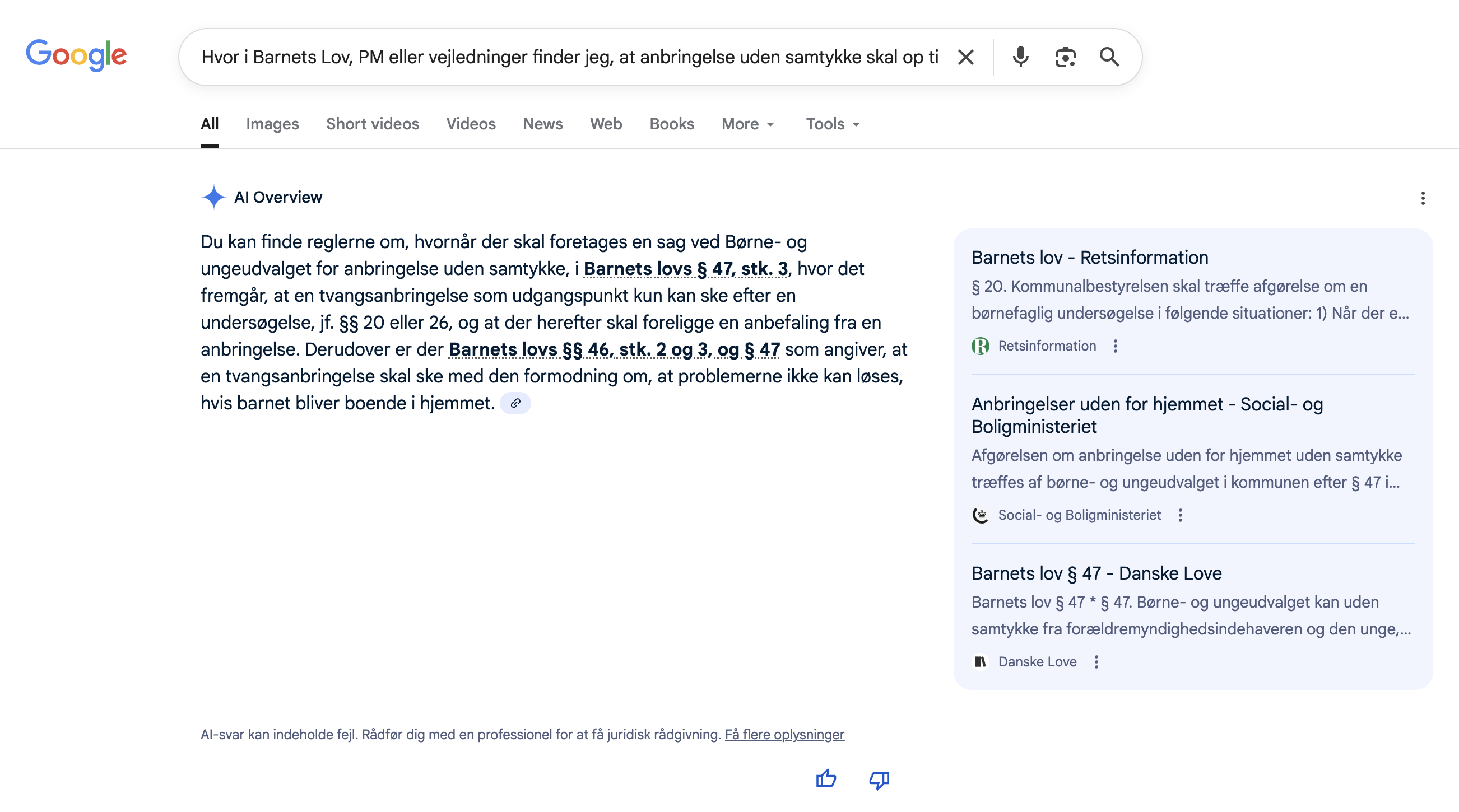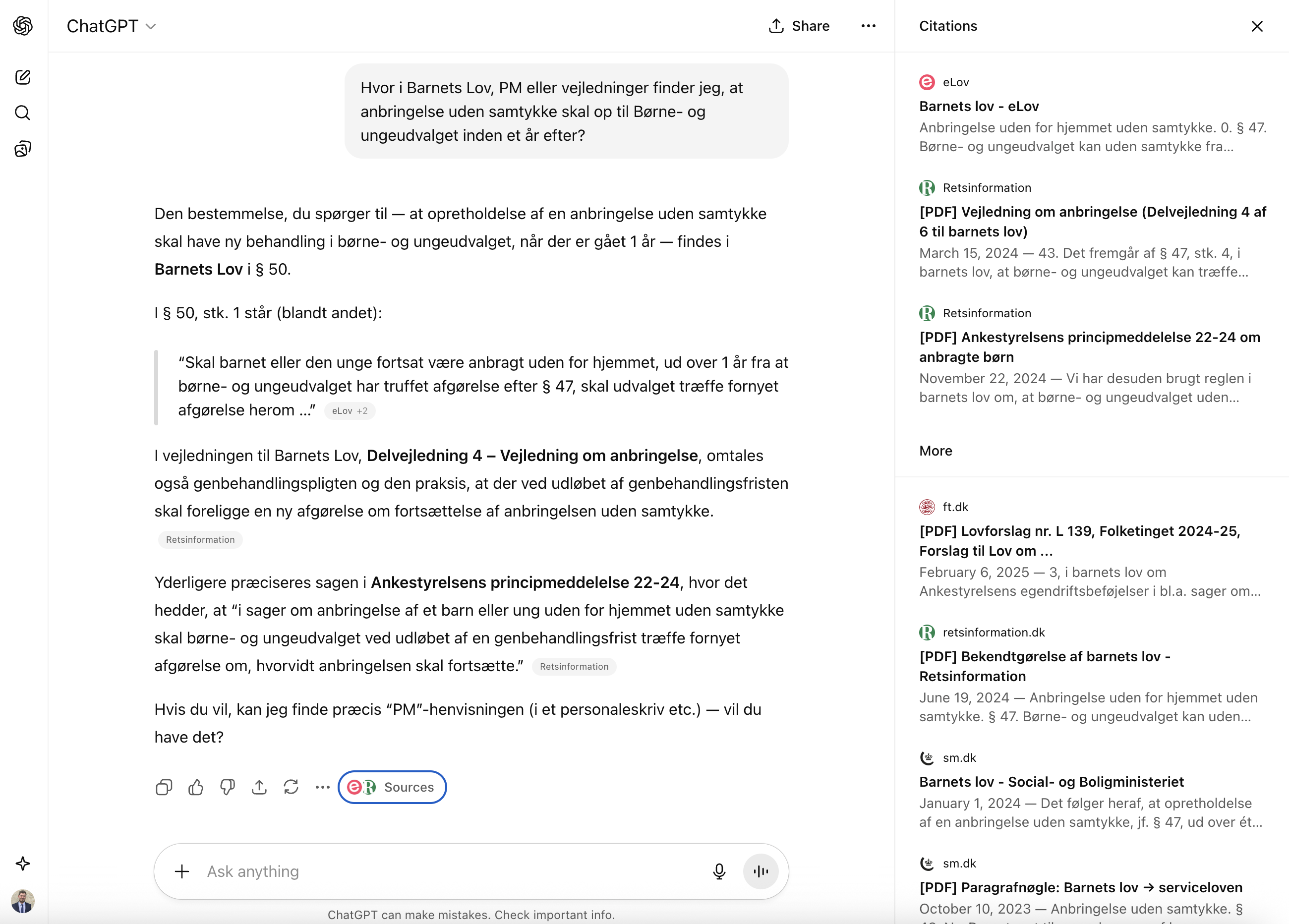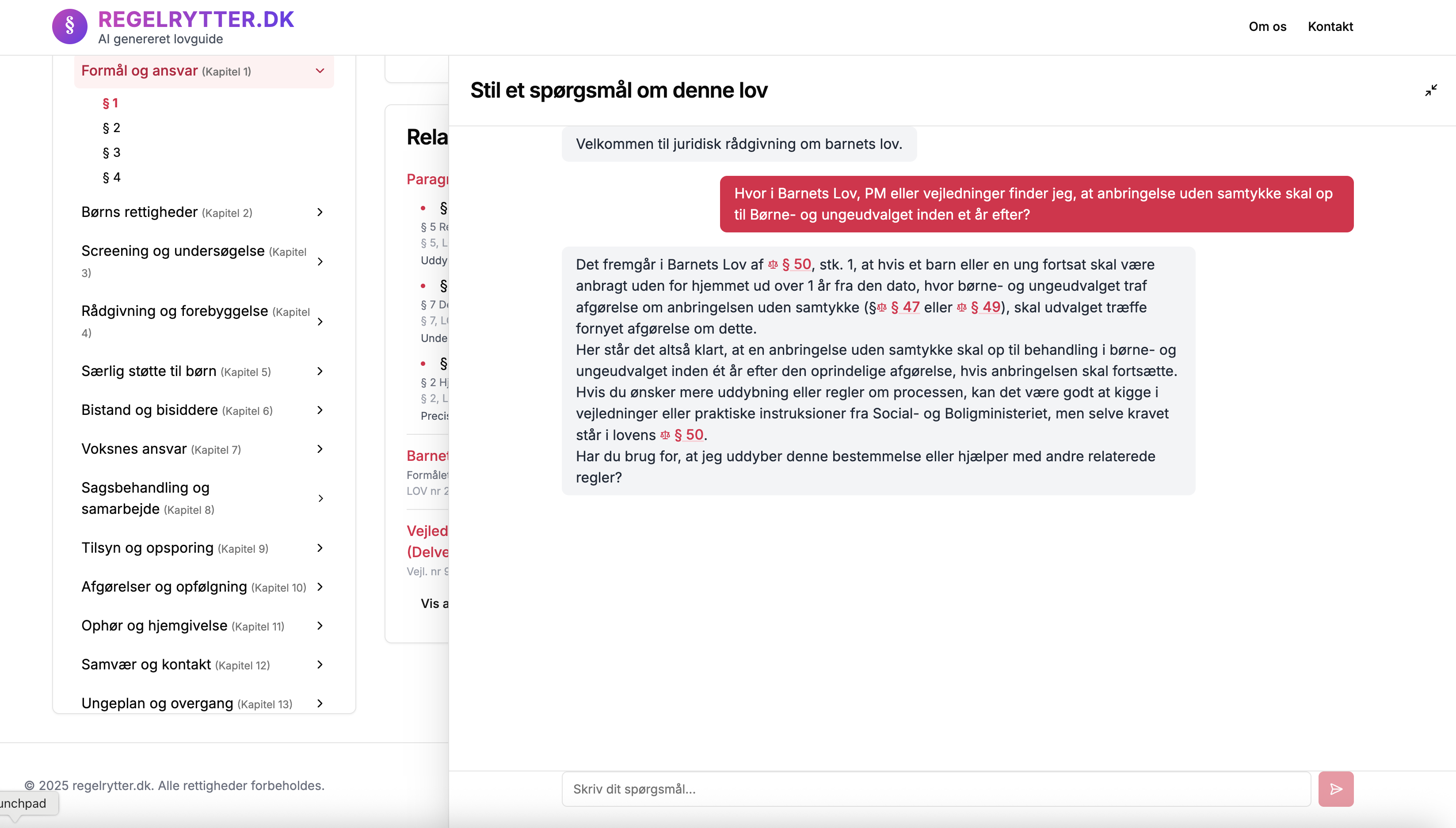Danish laws are hard to Google. Legal language is complex. AI tools often give plausible answers—but are they correct?
After 6 months with regelrytter.dk, I have 519 conversations to analyze. What are Danes searching for? Which AI tools give the best answers?
Here's the data from the comparison.
The Test: A Social Worker's Question
One of the most frequently searched sections in our data is § 115 of Barnets Lov (The Children's Act), which deals with placement of children without parental consent. This is a critical procedural area that affects child welfare cases across Denmark.
Here's a question from our data:
"Hvor i Barnets Lov, PM eller vejledninger finder jeg, at anbringelse uden samtykke skal op til Børne- og ungeudvalget inden et år efter?"
Translation: "Where in the Children's Act, practice memorandums, or guidelines do I find that placement without consent must go to the Children and Youth Committee within one year?"
Why this matters: A social worker needs precise procedural guidance. Getting the wrong answer or incomplete information could have serious legal consequences for both the municipality and the families involved. This isn't a casual question—it's a professional seeking authoritative, verifiable guidance.
Let's see how three different AI tools handle this question.
Screenshot 1: Google AI Response

Google AI
Screenshot 2: ChatGPT Response

ChatGPT
Screenshot 3: regelrytter.dk Response

regelrytter.dk
Feature Comparison: General AI vs. Specialized Legal AI
How different AI tools handle a real Danish legal question
| Feature | Google AI | ChatGPT | regelrytter.dk |
|---|---|---|---|
| Correct primary paragraph | ✗ § 47 (wrong) | ✓ § 50 | ✓ § 50 |
| Links to actual law text | Search results only | Via sources panel | ✓ Clickable inline |
| References administrative precedents | No | ✓ In sources | ✓ Integrated |
| Cross-references related sections | Limited | In sources | ✓ § 47, § 49 inline |
| Source integration | Separate results | 8 sources panel | ✓ Inline + sidebar |
| Verifiable citations | Below AI answer | Right panel | ✓ In-context |
| Danish law specialization | No | No | ✓ Purpose-built |
| Law structure navigation | No | No | ✓ Full sidebar |
What Makes regelrytter.dk Different
The comparison reveals important differences in both accuracy and presentation:
Accuracy matters
Google AI cited § 47 as the primary answer—but the correct paragraph is § 50, which specifies the deadline for when placement cases must return to Børne- og ungeudvalget. Both ChatGPT and regelrytter.dk correctly identified § 50. For a social worker preparing a case, citing the wrong paragraph could have serious consequences.
Source integration matters
- Google AI provides an overview but separates the AI answer from search results. Users get general guidance but must click through to various sources to verify details.
- ChatGPT has improved significantly with its sources panel, showing 8 relevant sources including Retsinformation PDFs and principmeddelelser. However, sources appear in a separate panel rather than being integrated into the answer flow.
- regelrytter.dk integrates everything into a unified experience: clickable paragraph references within the answer, full law text in the sidebar, related sections highlighted inline (§ 47, § 49), and principafgørelser accessible in context. The user never leaves the interface to verify or explore.
The difference: Getting the right answer is table stakes. How you present verifiable sources and legal context determines whether a tool is useful for professional work.
User Intent Patterns: What Are People Actually Searching For?
Observing search patterns during our first 6 months of operation reveals clear trends in how Danes interact with legal information. Here are the most frequently searched laws and what users are trying to understand:
1. Lejeloven (Rental Law)
- User intent patterns: Landlord-tenant disputes, rental deposit procedures, repair responsibilities, rental increase regulations
- Most popular section: § 170 - eviction and termination rights
- Example intent: "Users frequently seek clarity on deposit return procedures and landlord obligations when tenants move out"
- Value add: Linking to related sections about rental contract terms and tenant protection laws
2. Planloven (Planning Law) - 49 inquiries
- User intent patterns: Local development restrictions, zoning regulations, municipal planning requirements
- Most popular section: § 33 (21 inquiries) - local planning provisions
- Example intent: "Property owners wanting to understand what they can and cannot build on their land"
- Value add: Cross-referencing building regulations and environmental protection clauses
3. Barnets Lov (Children's Act) - 34 inquiries
- User intent patterns: Child welfare services, parental rights during municipality interventions, special needs support procedures
- Most popular section: § 115 (14 inquiries) - contact person for youth over 18 who have been placed without consent
- Examples from data:
- Social workers seeking clarity on support obligations for young adults after placement
- Questions about when and how to appoint contact persons
- Parents understanding their rights regarding transportation costs for special daycare facilities
- Clarification on what qualifies as "extraordinary expenses" under the act
- Why § 115 is frequently searched: It addresses ongoing support for young adults transitioning out of placement. Understanding these obligations is crucial for municipalities and families.
4. Straffeloven (Penal Code) - 49 inquiries
- User intent patterns: Understanding criminal liability, defamation laws, fraud definitions
- Most popular section: § 155 (6 inquiries) - false accusations
- Example intent: "Individuals wanting to understand the boundaries between legitimate complaints and legally actionable false accusations"
5. Forsikringsaftaleloven (Insurance Contract Act) - 40 inquiries
- User intent patterns: Insurance claim disputes, coverage interpretation, insurer obligations
- Most popular section: § 29 (8 inquiries) - duty of disclosure
- Example intent: "Policyholders questioning whether their claim denial was lawful based on disclosure requirements"
6. Færdselsloven (Road Traffic Act) - 36 inquiries
- User intent patterns: Traffic violations, parking rules, liability in accidents
- Most popular section: § 1 (10 inquiries) - general provisions and definitions
- Example intent: "Drivers wanting foundational understanding before diving into specific traffic offense penalties"
The Principafgørelse Advantage: Why Context Matters
One of regelrytter.dk's key differentiators is the integration of principafgørelser—administrative precedents from Ankestyrelsen that show how laws are actually interpreted and applied in real cases.
Using our § 115 example: The statute alone tells you that placement without consent must go before the Children and Youth Committee within one year. But what does "within one year" mean in practice? What documentation is required? How have similar cases been handled?
Principafgørelser provide:
- Real case outcomes showing how the law was applied
- Interpretation of ambiguous terms and timelines
- Procedural best practices
- Documentation requirements
- Examples of what constitutes compliance vs. violation
Before regelrytter.dk:
A social worker would need to:
- Read the statute (complicated legal Danish)
- Manually search Ankestyrelsen's database
- Read through dozens of decisions to find relevant ones
- Interpret how they apply to their situation
- Cross-reference multiple practice memorandums
Total time: 2-3 hours
With regelrytter.dk:
- Ask the question in plain language
- Get the specific paragraph, AI explanation, AND relevant precedents
- Click through to read full context if needed
Total time: 2-5 minutes
This is why specialized legal AI tools matter. General chatbots can't provide this level of integrated, authoritative guidance.
How Data Collection Works: Category-Based Learning
Understanding how users interact with legal information requires capturing patterns—but doing so responsibly is paramount when dealing with sensitive legal queries.
Our approach:
- When the AI answers questions, it logs the intent and subject of each inquiry into generic categories (e.g., "rental deposit procedures", "child placement criteria", "traffic violation penalties")
- These categories form the basis of our data analysis—allowing us to understand what legal topics generate the most inquiries
- No personal information, conversation details, IP addresses, or user identifiers are retained
- Think of it as understanding that "rental deposits generate significant search activity" rather than knowing "John from Copenhagen asked about his specific deposit dispute"
The data presented in this case study comes from these generic category logs. When we see 50 inquiries related to Lejeloven, that represents 50 times the AI categorized a question as relating to rental law—not 50 stored conversations. This approach lets us identify which laws need better explanations and which procedural areas cause the most confusion, without ever compromising individual privacy.
What This Data Tells Us About Legal Access in Denmark
The patterns emerging from 519 inquiries reveal important insights about how Danes interact with law:
1. Citizens are actively seeking to understand their rights
The high volume of searches across diverse legal areas (rental law, planning law, child welfare, criminal law, insurance law, traffic law) shows that legal information needs cut across all aspects of daily life. People aren't avoiding the law—they're struggling to understand it.
2. Property and family law generate the highest inquiry volume
Lejeloven (50 inquiries) and Planloven (49 inquiries) together account for nearly 20% of all searches. These are areas where citizen-authority conflicts are common and where ordinary people need quick, accurate answers.
3. Social sector professionals need specialized tools
The 34 inquiries about Barnets Lov—with 14 specifically about § 115—reveal that public employees working with complex procedural requirements need more than generic AI answers. They need source-integrated, precedent-linked guidance.
4. General-purpose AI tools aren't built for this
As our comparison demonstrates, ChatGPT and Google AI provide plausible-sounding but unverifiable answers. For professionals like social workers, accuracy isn't nice-to-have—it's essential. For citizens trying to understand their rights, verifiable sources build trust.
5. There's a market gap for Danish-specific legal AI
The success of regelrytter.dk—gaining organic search traction within a week—suggests strong demand for specialized legal AI tools that integrate authoritative sources rather than relying solely on LLM training data.
Conclusion: Specialized AI Wins When Precision Matters
When a social worker asks about child placement procedures, they need precision, sources, and context—not a plausible-sounding answer. Our analysis of 519 inquiries demonstrates exactly why:
- General AI tools provide answers, but lack verifiable sources and legal context
- regelrytter.dk provides answers WITH sources, principafgørelser, and the ability to explore full legal context
- The difference isn't academic—it's 2-5 minutes vs. 2-3 hours of research
- For professionals, it's the difference between confident guidance and risky guesswork
The patterns in our data show exactly where Danish law is hardest to navigate: rental disputes, planning restrictions, child welfare procedures, criminal liability, insurance claims, and traffic regulations. These are the areas where ordinary people need help—and where AI can truly democratize access to legal knowledge.
But only if that AI is built for purpose.
General-purpose chatbots will always have limitations for specialized domains like law. The future of legal AI isn't just about making language models bigger—it's about making them verifiable, source-integrated, and contextually aware.
That's what regelrytter.dk demonstrates. And that's what 519 users have validated with their inquiries.
Try it yourself: Visit regelrytter.dk and ask your own Danish legal questions. See how specialized AI with source integration compares to what you'd get from ChatGPT or Google AI.



